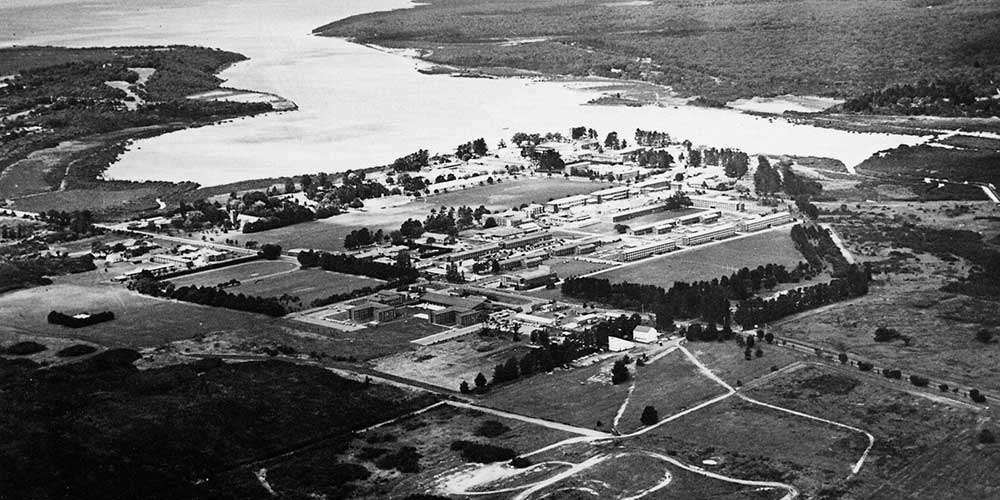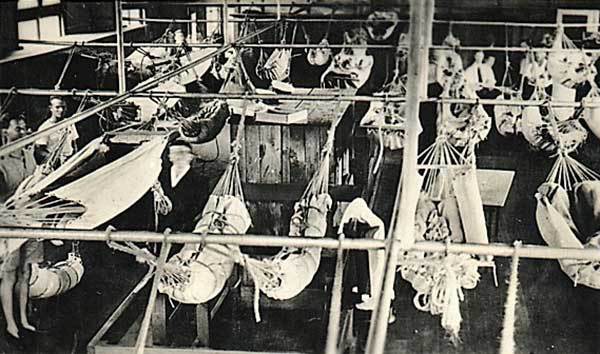The RAN establishment, HMAS Cerberus covers an area of 1517 hectares and is 70 kilometres from Melbourne near Crib Point on Hann’s Inlet, Western Port Bay. HMAS Cerberus and the area surrounding it is recognised by the Department of Environment and Energy as being of high geomorphological, botanical and zoological significance and Western Port as a whole, a wetland of international significance.

Purchased in 1911 and called Flinders Naval Depot, it was commissioned as HMAS Cerberus 10 years later. It comprises numerous training and recreation facilities, two chapels, small marina and attractive grounds.
The primary role of HMAS Cerberus has always been Navy personnel training. Within the establishment today are several tri-service schools training personnel from the three services in addition to traditional naval schools.
Despite the addition of modern buildings, the historic character of HMAS Cerberus remains. Its historic presence, heritage buildings, chapels, sports facilities and gardens are conducive to an effective training environment.
Navy-specific training units include; the School of Survivability and Ship Safety, which specialises in firefighting, damage control and nuclear biological chemical defence, seamanship and weapons training. HMAS Cerberus is also the home of the Recruit School and, for all sailors, their first contact with life in the Navy.
Tri-service schools include the:
- ADF Physical Training School,
- Administrative cell for the ADF School of Catering (Navy & Army) with actual training conducted by a commercial provider external to HMAS Cerberus,
- RAAF Initial Technical Training conducted in the Navy Engineering Faculty,
- ADF Dental Training School,
- Defence Force School of Signals – Maritime Wing and
- ADF Investigation Service (ADFIS) – Joint Investigation Office
About 6000 personnel are currently trained annually, averaging 800 trainees onboard at any one time.


Heritage Significance
HMAS Cerberus, is historically significant for the following reasons;
- Its creation was intimately associated with the newly formed Royal Australian Navy (RAN) in 1911.
- The complex is the largest, most significant and longest continuously functioning training facility held by the RAN and it is associated with the development of Australia’s naval forces since the Navy’s earliest days.
- Since 1921 HMAS Cerberus has trained countless numbers of RAN personnel.
- The development of the complex reflects Australia’s naval history since the early part of the twentieth century.
- The complex has one of the largest ADF ceremonial grounds in Australia.
- The central area is outstanding for its design excellence. Consisting of the Parade Ground and selected surrounding buildings, the complex is of monumental scale and distinctive formality, and it exhibits distinguished architecture of the early twentieth century.
- A number of eminent Australians are associated with HMAS Cerberus. These include; Vice Admiral Sir William Creswell, Captain William Clarkson and Commonwealth architect John Smith Murdoch.
History
Purchased in 1911, construction commenced in 1913 with plans to incorporate a Torpedo School, a Destroyer Base and a Submarine Base, and be capable of accommodating up to 2000 personnel. A wharf and hospital were erected first, followed by A, B and C Blocks. The Wardroom, Warrant Officers’ Mess, Captain’s and other Officers’ residences were built between 1915 and 1917. The Drill Hall, Gunnery School and Torpedo School were established in 1917 at the height of building activity. The power house and other residences were built between 1918 and 1920. Brief descriptions of individual buildings in the original ‘central group’ are available in the Commonwealth Heritage list.

The base was officially opened in September, 1920. The idea of using it as a Fleet Base was soon abandoned and it became known as Flinders Naval Depot in 1921. It was commissioned HMAS Cerberus on 1 April 1921.
In 1930, during a period of Naval retrenchment, the Royal Australian Naval College moved from Jervis Bay to HMAS Cerberus, where it remained until 1958 when it returned to Jervis Bay.
The outbreak of World War II found the facilities inadequate to deal with the needs of wartime recruits who were passing through Cerberus at the rate of 400 a month. Temporary buildings were erected to cope with the needs of this sudden influx.

The first WRANS arrived in 1942 and, apart from a short post-war break, were a part of the RAN ever until 1985. 1942 also saw the introduction of an Officers’ Training School to train selected recruits as officers for war service. The school trained 1000 sailors during the war and closed in 1945.
Since 1945 many of the temporary buildings have been progressively dismantled and replaced.
The Roman Catholic Chapel, Our Lady Star of the Sea, was opened in 1948, followed by St. Mark’s Chapel in 1954. Other additions include the present accommodation blocks, cinema, Senior Sailors’ Mess, Club Cerberus, Gymnasium and Aquatic Centre, Seamanship School and Wharf, Communications School, Recruit School and Health Centre.

The phasing out of apprentice training, the closure of HMAS Nirimba and the introduction of Tri-Service training resulted in many changes at HMAS Cerberus.
Training
After graduating from Recruit School, sailors are promoted to Seaman Star placed into small groups of about 12 – 20 people known as a Division and undertake training at their respective category school.
The following training schools located in HMAS Cerberus. Details are available on the HMAS Cerberus website.
- Recruit School
- School of Ships Safety and Survivability
- Engineering Faculty
- Defence Force School of Signals
- Supply and Health Faculty
- School of Music

Cerberus (I)
HMAS Cerberus continues the name of one of the first modern battleships, the iron clad HMVS Cerberus, acquired by the Victorian Government for its colonial navy in 1870. The remains of HMVS Cerberus form a breakwater at Black Rock in Port Phillip. The site is also on the National Heritage List. The history of HMVS Cerberus is available on this website.

Further Reading
Cerberus in Wartime by Hugh Jarrett, published March 2004 edition of the Naval Historical Review RAN Communications Branch Association, History of the RAN Communications and Information Systems School



